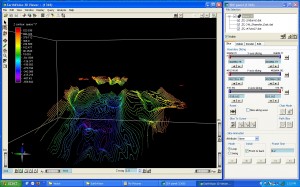Fears that the development of the Marcellus Shale natural gas reserves might lead to anthracite mining era-style environmental degradation are well founded. This is especially true as it relates to protecting the sources of water that we need to survive.
It is ironic, then, to learn that the natural gas and coal industries, both intent on extracting resources from underground, are linked today. The linkage is in the vast water pools in former mine workings, water that can be tapped for fracking. That is the process whereby water is injected under high pressure into the shale deposits that hold the natural gas, breaking up the shale to allow the gas to escape and be captured.
There are billions of gallons of water in the anthracite coal fields. The total could be more than one trillion gallons, according to Robert Hughes of the Eastern Pennsylvania Coalition for Abandoned Mine Reclamation (EPCAMR). His agency and the Susquehanna River Basin Commission (SRBC) are engaged in high-tech mapping of underground water pools in the anthracite fields.
The mapping also reveals existing coal deposits. There are billions of tons of coal underground. Yes, billions of tons, and that coal, the billions of gallons of water and even the 65 or so mine fires burning in Pennsylvania all mean that bountiful resources exist that could create, build, and sustain economic models that could inure to the benefit of all Pennsylvanians.
The key is developing each resource so it can turn a profit for whatever entity does the developing, whether it is a private company or a government entity.
The spark that led this column to talk to Hughes was a letter to the editor from Jude O’Donnell of Harvey’s Lake, Pennsylvania. He wondered if the tremendous energy being generated by the Laurel Run Mine Fire might be harnessed. The fire has been burning underground on the mountain east of Wilkes-Barre since 1915. In the 1950s, all homes in the mine fire area were taken by the federal government and the fire was sealed with a clay barrier.
Hughes said O’Donnell’s idea has merit. A plant could be built outside the fire zone and the heat could be piped to the plant and converted by one of several processes into energy. That energy could heat homes or businesses, or sold, perhaps by a local government or consortium of local governments working together. Can you say “regional cooperation?”
The same could be done at other mine fires throughout the state, including Centralia, the famous fire that led to the abandonment of a community in southern Columbia County, Pennsylvania.
The energy from mine fires likely will last for generations, Hughes said, just as the billions of gallons of water in underground mines will be there for centuries. The mapping partners are looking at historical data on water levels, recorded at boreholes all over the anthracite fields, and safe withdrawal levels can be established. This would preclude mine subsidence threats.

Mine water is undrinkable and unusable, except for industrial uses such as fracking, because of its iron content. However, waste water from fracking becomes dangerous if it enters aquifers, reservoirs, streams, and rivers that are used as drinking water sources. This is the key issue on which critics of natural gas development are focused, with good reason.
Then there is the coal. Strip mining continues, especially in the Southern Anthracite Coal Field, but few deep mines exist. The last to operate in the Wyoming Valley was the Glen Nan Mine in Newport Township, the closing of which I covered in 1974. It will take technological breakthroughs and an industry commitment to environmental protection before anyone can get excited again about tapping the massive coal reserves.
The mapping project will be invaluable to those watchdog groups and citizens worried about the Commonwealth’s water resources. In addition to the use of aquifers, lakes, and streams by gas companies, we must add mine water pools, which should not be discounted, regardless of acidity, as a major part of overall Pennsylvania water resources.
Paul Golias, retired managing editor of The Citizens’ Voice, writes a weekly column on regional issues. He can be contacted at pgolias@ptd.net.
Read more: http://citizensvoice.com/news/mapping-of-underground-water-pools-1.1164422#ixzz1QCMrY1RE












You must be logged in to post a comment.